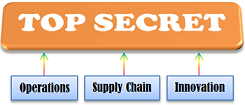“Well, that is a part of the magic of Apple. And I don’t want to let anybody know our magic because I don’t want anybody copying it.”
– Apple’s Tim Cook in 2011 in reply to a question on how Apple does it.
Product launch events or major announcements at developer conferences are not something new. The surprise element at these events is critical and viewed as powerful to brand strategy. A new product feature or information is something all companies try to protect from being leaked. Accordingly, many companies use operational secrecy as a strategy, limited not just to its communications department but as integral to its corporate culture. The secrecy helps develop trust in the team and fellowship among employees. Companies have internal security teams and employees can even be fired for leaking information. Some companies have gone so far as to spreading disinformation about product plans to its own employees. When Apple’s iPod was launched, its own employees were as surprised as all others.
Many corporate governance experts view hiding information as lack of transparency in not disclosing information to the marketplace or stakeholders. But companies especially in the technology industry like Apple, Nokia and Google are getting a reputation for non-disclosure of their next innovation. However, these companies thrive on constant and discrete product innovation. They have built fanatic consumer loyalty and enjoy a high level of profitability with high volumes by avoiding ‘me-too’ products.

Apple’s private supply chain
Three traits of Steve Jobs’ success with Apple that stand out are attention to detail, constant feedback and secrecy around its famed product unveiling. Apple is known to maintain pre-launch secrecy of its products going as far as placing electronic monitors to track it’s yet to be released products across its supply chain. So the company, shipping it’s yet to be released products in tomato boxes to avoid detection is not surprising. Apple even took its fixation with secrecy to the courts. The secrecy culture began with the release of its first Macintosh. Competitors like Microsoft and Sony already had information about it before its launch.
When Jobs walked out with an envelope in hand during an Apple keynote, not many suspected that it would contain the ultra-thin MacBook Air. The surprise and wow on the faces of the audience was a moment to capture. Apple is reportedly working on the iWatch and could also announce Apple Television in future.
Nike’s secret labs
Reportedly, Nike has a secretive lab at its headquarters in Oregon known as the Sparq performance center. Other Nike’s mysterious R&D labs are ‘Zoo’ and the ‘Innovation Kitchen’. The idea behind such secretive labs is simple. Nike does not want details of its R&D leaked out. No photos should be clicked in these highly restricted areas where not many employees have access.
Google’s secret projects
Google also has its well-known ‘Google X lab’ to work on secret projects like space elevators, driver-less cars and Google Glass. Though the projects are not secret anymore with the company releasing information via various channels, the idea is to fuel public perception and foster an internal culture. But you just might not know the next big idea coming out of the secret lab.
